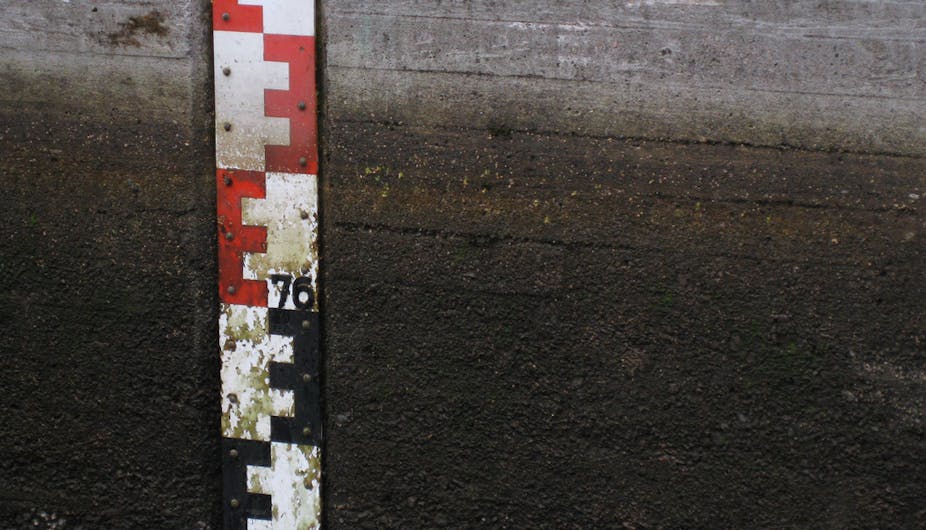In 2100, will sea level be one metre higher than now, or only 50cm? The Thames Barrage is designed to protect London from flooding by storm surges in up to one in a thousand year events. With 50cm higher seas this becomes one in a hundred years. At one meter above present it is one in ten years. This stuff matters.
That was the message from David Vaughan of the British Antarctic Survey, given as a plenary talk at the 25th General Assembly of the International Union of Geodesy and Geophysics.
Over nine days, more than 3200 scientists from 92 countries have gathered in Melbourne, with 3200 talks in 198 symposia and almost 2000 posters.
With the theme: “Earth on the edge”, the IUGG assembly has had a focus on both the natural hazards of earthquakes and tsunamis, as well as natural and anthropogenic climate change.
This rich and lively interaction between scientists provides stark contrast to typical media coverage, and raised the question: what are some of the real debates in climate science?
Presentations at large meetings like the IUGG Assembly span a range of forms that illustrate the progression of scientific debates. At plenary sessions, world leading scientists give overviews of the well-established science, augmented with descriptions of the real debates and often concluding with tentative ideas of where the field might go in the future.
Keynote talks present more formal views targeted at specialists, but give others a chance to see the state of field other than their own. Other talks and posters present work at less advanced stages, from the recently published, through to initial summaries of ideas and work in progress. These include technical talks where one can watch “rivals” question each other.
This is where real debates in science often take shape, before moving on to the peer-reviewed literature. Overall these meetings capture:
What is known?
What is not known?
Within the unknown, what are the possibilities?
What information do we have or need that might resolve the unknowns?
Saying that debate about climate is closed is a rather silly way of describing what has really happened: debate has moved on as old debates have died. This doesn’t mean that old debates can’t be revived if new evidence is found, but for the core science of the greenhouse effect, this has not yet happened.
What is the impact of the sun?
A series of sessions explored solar variability and its effects on climate, and implicitly whether solar changes could be causing recent temperature trends. An invited keynote talk by Werner Schmutz describes the radiative energy from the sun: total solar iradiance or TSI.
He concluded that the “data do not support a TSI trend between 1996 and 2008” (from one solar min to the next); other presentations explored details.
Solar cycle 24 is building up after a longer-than-normal solar minimum, and some are asking if this cycle is abnormal. Probably no, according to several presentations although this will only be settled by what the sun does over the next decade.
However, if the cycles turns out be abnormal and the sun heads into something like the Maunder minimum of Little Ice Age times, how much would it reduce the warming from greenhouse gas emissions? Not much, according to the presentation by G. Feulner.
At the exploratory end, Renata Lukianova asked whether a solar spike in 2004 had a discernible impact on atmospheric temperatures. Schmutz proposed a new classification of solar states that redefined the use of isotopes for reconstructing past solar variability. This increases the estimates of change in radiative forcing since the Maunder minimum (but gives little change over the 20th century).
Where to for wind and water?
Debates about stronger hurricanes in a warmer world are no longer about “if” but more about “how”.
Debate is over the details of the process of intensification with time (for example, from category 1 to 4). In particular, scientists are asking whether the wind-speed dependence of surface evaporation rate is crucial to how a hurricane strengthens.
The plenary by Anny Cazenave reviewed 20th century sea level changes. The century average was 1.7 mm/year, but it increased to 3.3 mm/year over the period since satellite measurements began.
Previously, roughly equal contributions came from thermal expansion, glacier melt and loss from the the Greenland ice cap. Since 2004, with slower ocean warming, the proportion has changed (without the total rate changing much), and now most sea-level rise is driven by ice-melt.
Debate about future rises in sea-level hinges on debates about the stability of the Greenland and Antarctic ice-sheets. It is here that resolving debates about past behaviour of ice sheets can contribute.
Questions that are still under debate include:
What caused the change in ice age cycles about a million years ago from a 41,000-year cycle to a larger and longer 100,000-year cycle?
What set the limits to the deglaciation at the end of the ice ages?
Why did the most recent deglaciation stop with temperatures lower and sea level lower than about 100,000 years ago in the Eamean period?
David Vaughan’s conclusion was that by 2100, sea-level rise would be not much less than 50 cm: this is locked in from the effects of past emissions. At the upper end he found it hard to conceive of more than 1.5 metres, as this would imply ice melting faster than during the last deglaciation. He believes 1 metre is a more likely upper estimate.
Within the 0.5 to 1.0 metre range, the debate continues.

